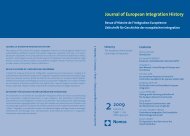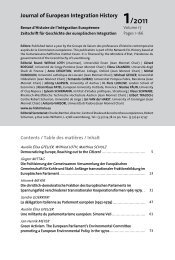journal of european integration history revue d'histoire de l ...
journal of european integration history revue d'histoire de l ...
journal of european integration history revue d'histoire de l ...
You also want an ePaper? Increase the reach of your titles
YUMPU automatically turns print PDFs into web optimized ePapers that Google loves.
88<br />
Hans-Otto Frøland<br />
vate investment. Through the state budget and forced regulation <strong>of</strong> the bond market<br />
the authorities led a relatively large proportion <strong>of</strong> savings over into a network <strong>of</strong><br />
public funds and State investment banks. This national credit rationing could not be<br />
maintained if the movement <strong>of</strong> capital was liberalised. With a low interest rate, private<br />
savings would disappear abroad and there would be even less capital for investments.<br />
This explains why Norwegian governments feared the Community directive<br />
on the liberalisation <strong>of</strong> capital movements. Moreover, with less control over<br />
overall investments, the tra<strong>de</strong> union movement would in all probability lose interest<br />
in wage mo<strong>de</strong>ration and the post-war bargain would crumble.<br />
The importunate political problem <strong>of</strong> the mo<strong>de</strong>rnisation strategy was nevertheless<br />
that the majority <strong>of</strong> the electorate could be found in the sheltered sector <strong>of</strong> the<br />
economy. In the 1930s, both the agriculture and fisheries were forced into cartels<br />
and shiel<strong>de</strong>d against competition from abroad. During the inter-war period a large<br />
industry based on handicrafts had emerged selling to local markets and this had accounted<br />
for approximately ninety per cent <strong>of</strong> employment growth in the 1930s.<br />
This industry, by planners referred to as the domestic market industry, continued to<br />
enjoy extremely good terms until quota liberalisation was implemented in the<br />
1950s. In 1950, twenty-eight per cent <strong>of</strong> employment was in the primary sector<br />
while industry only employed twenty four percent. The majority <strong>of</strong> industrial employees,<br />
moreover, produced for a protected domestic market. Estimates in the late<br />
1950s said that about seventy-five per cent <strong>of</strong> the employment in industry was in<br />
the domestic industry. A mo<strong>de</strong>rnisation strategy seeking to survive politically<br />
would need to consi<strong>de</strong>r this fact. To avoid social dissatisfaction and political- protest<br />
movements, the sheltered sector, which was labour intensive and had a low productivity<br />
rate, would have to be mo<strong>de</strong>rnised more carefully. Governments accordingly<br />
chose to maintain the compromise with agrarian and rural interests. An<br />
expression <strong>of</strong> this was the 1950 parliamentary <strong>de</strong>cision that the income <strong>of</strong> farmers<br />
would follow the average wage <strong>of</strong> industrial workers. A negotiation system was<br />
also introduced between the government and agricultural organisations with respect<br />
to income <strong>de</strong>velopments in agriculture. A similar system was later introduced in the<br />
fisheries sector. The production structure and income level in the primary sector<br />
was thus completely <strong>de</strong>pen<strong>de</strong>nt on price regulations, State subsidies and protection.<br />
Similar consi<strong>de</strong>rations were attempted for lagging industry through an emphasis on<br />
the income policy in wage settlements that were conceived in terms <strong>of</strong> social solidarity.<br />
Hence an inflationary bias was established in the protected sector <strong>of</strong> the<br />
economy which the governments, by means <strong>of</strong> subsidy policies, converted into political<br />
business cycles. Inflation was tamed prior to elections. 34<br />
The sheltered industry consisted <strong>of</strong> many companies, each with relatively few<br />
employees and little capital equipment. Planners explained that this structure came<br />
about because <strong>of</strong> the limited domestic market. Consequently, part <strong>of</strong> the long-term<br />
34. O. AUKRUST, Inflation in the open economy: the Norwegian mo<strong>de</strong>l, in: L.B. KRAUSE and W.S.<br />
SALANT, Worldwi<strong>de</strong> Inflation: Theory and Recent Experience, Washington, 1977, pp.107-153;<br />
and FRØLAND, Corporatism within organized capitalism. Norwegian incomes policy 1935-1965,<br />
in: Jahrbuch für Wirtschaftsgeschichte, 1993/2, pp.191-218.

















